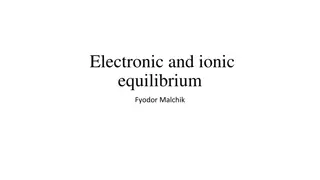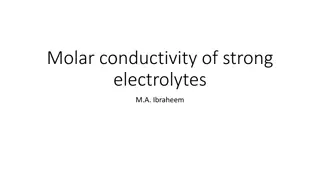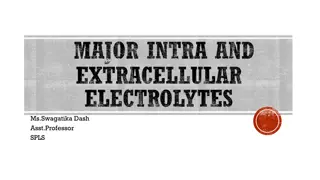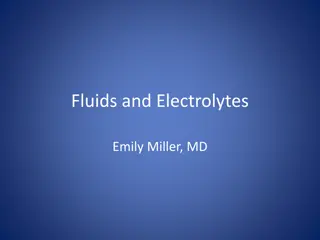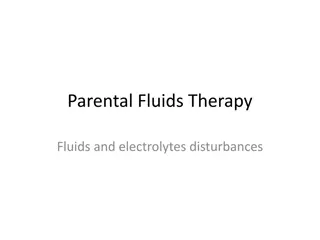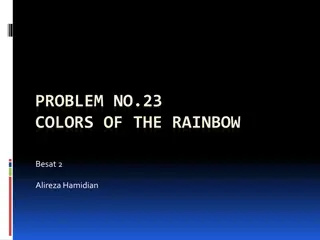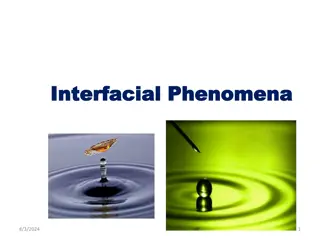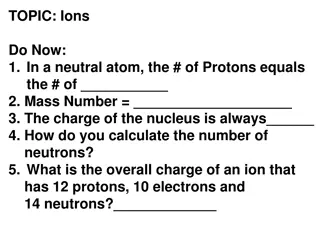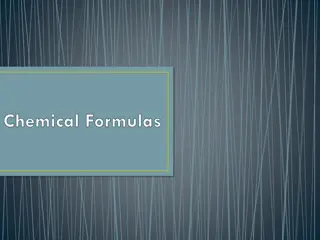Understanding Electrolytes in Chemical Solutions
The content discusses the concept of electrolytes in chemical compounds, exploring how they can remain intact or dissociate into ions in solution. It explains the roles of electrolytes in body fluids, their movement in the presence of electrodes, and the use of electrolyte preparations in clinical practice. It also compares the use of milliequivalents in the United States with molar concentrations in the International System for expressing electrolyte levels.
Download Presentation

Please find below an Image/Link to download the presentation.
The content on the website is provided AS IS for your information and personal use only. It may not be sold, licensed, or shared on other websites without obtaining consent from the author. Download presentation by click this link. If you encounter any issues during the download, it is possible that the publisher has removed the file from their server.
E N D
Presentation Transcript
By By Ali Ali Khidher Khidher Alobaidy Alobaidy
The molecules of chemical compounds in solution may remain intact, or they may dissociate into particles known as ions, which carry an electric charge. Substances that are not dissociated in solution are called nonelectrolytes, and those with varying degrees of dissociation are called electrolytes. Urea and dextrose are examples of nonelectrolytes in body water; sodium chloride in body fluids is an example of an electrolyte. Sodium chloride in solution provides Na+and Cl-ions, which carry electric charges.
If electrodes carrying a weak current are placed in the solution, the ions move in a direction opposite to the charges. Na+ions move to the negative electrode (cathode) and are called cations. Cl- ions move to the positive electrode (anode) and are called anions. Electrolyte ions in the blood plasma include the cations Na+, K+, Ca++, and Mg++and the anions Cl-, HCO3-, HPO4--, SO4--, organic acids, and protein. Electrolytes in body fluids play an important role in maintaining the acid-base balance in the body. They play a part in controlling body water volumes and help to regulate body metabolism.
Electrolyte preparations are used in the treatment of disturbances of the electrolyte and fluid balance in the body. In clinical practice, they are provided in the form of oral solutions and syrups, as dry granules intended to be dissolved in water or juice to make an oral solution, as oral tablets and capsules and, when necessary, as intravenous infusions.
A chemical unit, the milliequivalent (mEq), is now used almost exclusively in the United States by clinicians, physicians, manufacturers to express electrolytes in solution. This unit of measure is related to the total number of ionic charges in solution, and it takes note of the valence of the ions. In other words, it is a unit of measurement of the amount of chemical activity of an electrolyte. pharmacists, the concentration and of
In the International System (SI), which is used in European countries and in many others throughout the world, molar concentrations [as milli-moles per liter (mmol/L) and micromoles per liter (_mol/L)] are used to express most clinical laboratory values, including those of electrolytes. The total concentration of cations always equals the total concentration of anions. Any number of milliequivalents of Na+, K+, or any cation_ always reacts with precisely the same number of milliequivalents of Cl_, HCO3_, or any anion. For a given chemical compound, the milliequivalents of cation equals the milliequivalents of anion equals the milliequivalents of the chemical compound.if we dissolve enough potassium chloride in water to give us 40 mEq of K+per liter, we also have exactly 40 mEq of Cl_, but the solution will not contain the same weight of each ion.
A milliequivalent represents the amount, in milligrams, of a solute equal to 1 1000 of its gram equivalent weight, taking into account the valence of the ions. The milliequivalent expresses the chemical activity or combining power of a substance relative to the activity of 1 mg of hydrogen. Thus, based on the atomic weight and valence of the species, 1 mEq is represented by 1 mg of hydrogen, 20 mg of calcium, 23 mg of sodium, 35.5 mg of chlorine, 39 mg of potassium, and so forth. Equivalent weight = Atomic or formula weight / Valence
To convert the concentration of electrolytes in solution expressed as milliequivalents per unit volume to weight per unit volume and vice versa, use the following: To convert milligrams (mg) to milliequivalents (mEq): mEq = mg x Valence/Atomic, formular, or molecular weight To convert milliequivalents (mEq) to milligrams (mg): mg = mEq x Atomic, formula, or molecular weight /Valence (mEq/mL) To milligrams per milliliter (mg/mL): mg/mL=mEq/mLx Atomic, formula, or molecular weight /Valence convert milliequivalents per milliliter to
What is the concentration, in milligrams per milliliter, of a solution containing 2 mEq of potassium chloride (KCl) per milliliter? Molecular weight of KCl = 74.5 Equivalent weight of KCl = 74.5 mg/mL = 2 (mEq/mL) x 74.5 / 1 = 149 mg/mL.
What is the concentration, in grams per milliliter, of a solution containing 4 mEq (CaCl2 2H2O) per milliliter? of calcium chloride Recall that the equivalent weight of a binary compound may be found by dividing the formula weight by the total valence of the positive or negative radical. Formula weight of CaCl2 2H2O = 147 Mg/ ml = 4 x147/2 = 294 mg/ml=0.294 g/ml Note: The water of hydration molecules does not interfere in the calculations as long as the correct molecular weight is used.
What is the percent (w/v) concentration of a solution containing 100 mEq of ammonium chloride per liter? Mg / L = 100 mEq/L x 53.5 / 1 = 5350 mg / L = 5.35 g/L 5.35 X 1000ml 100ml X = 0.535 %
A solution contains 10 mg/100 mL of K_ ions. Express this concentration in terms of milliequivalents per liter. Atomic weight of K =39 mEq/L = 100 (mg/L) x 1/ 39 = 2.56 mEq/L A solution contains 10 mg/100 mL of Ca+ +ions. Express this concentration in terms of milliequivalents per liter. Atomic weight of Ca+ += 40 10 mg / 100ml = (mEq/100ml) x 40 /2 = 0.5 mEq /100ml = 5 mEq / L
A magnesium (Mg+ +)level in blood plasma is determined to be 2.5 mEq/L. Express this concentrationin terms of milligrams. Atomic weight of Mg = 24 Mg / L = 2.5 (mEq/L) x 24 /2 = 30 mg / L How many milliequivalents of potassium chloride are represented in a 15-mL dose of a 10% (w/v) potassium chloride elixir? Molecular weight of KCl = 74.5 10g 100ml X 15ml X = 1.5g = 1500 mg mEq = 1500 x1 / 74.5 = 20.13 mEq How many milliequivalents of magnesium sulfate are represented in 1 g of anhydrous magnesium sulfate (MgSO4)? Molecular weight of MgSO4 = 120 mEq = 1000 x 2 / 120 = 16.7 mEq
How many milliequivalents of Na_ would be contained in a 30-mL dose of the following solution? Rx Disodium hydrogen phosphate 18 g Sodium biphosphate 48 g Purified water ad 100 mL Each salt is considered separately in solving the problem. Disodium hydrogen phosphate Formula = Na2HPO4.7H2O Molecular weight = 268 18g 100ml X 30ml X = 5.4 g = 5400 mg of disodium hydrogen phosphate per 30 mL mEq = 5400 x 2 / 268 = 40.3 mEq of disodium hydrogen phosphate Because the milliequivalent value of Na+ion equals the milliequivalent value of disodium hydrogen phosphate, then: x = 40.3 mEq of Na+ For Sodium biphosphate Formula = NaH2PO4.H2O Molecular weight = 138 48g 100ml X 30ml X = 14.4g = 14400 mg of sodium biphosphate per 30 mL mEq = 14400 x 1 / 138 = 104.3 Adding the two milliequivalent values for Na+= 40.3 mEq + 104.3 mEq = 144.6 mEq
A person is to receive 2 mEq of sodium chloride per kilogram of body weight. If the person weighs 132 lb., how many milliliters of a 0.9% sterile solution of sodium chloride should be administered? Molecular weight of NaCl = 58.5 Wt. kg = 132/2.2 = 60 kg 2 x 60 = 120 mEq Mg = 120 x 58.5 / 1 = 7020 mg = 7.02g of NaCl needed and because 0.9% sterile solution of sodium chloride contains 9 g of NaCl per liter, then 9g 1000ml 7.02g x X = 780 ml
electrolyte concentrations expressed in millimoles per liter (mmol/L) in representing the combining power of a chemical species. A mole is the molecular weight of a substance in grams. A millimole is one thousandth of a mole and a micromole is one millionth of a mole.
How many millimoles of monobasic sodium phosphate (m.w. 138) are present in 100 g of the substance? m.w. = 138 mole= wt. / m.wt. = 100/ 138 = 0.725 moles = 725 mmol or 1 mole = 138 g 1 mole 138 g X mole 100 g x = 0.725 moles = 725 mmol
How many milligrams would 1 mmol of monobasic sodium phosphate weigh? 1 mole = 138 g 1 mmol = 0.138 g = 138 mg What is the weight, in milligrams, of 1 mmol of HPO4- -? Atomic weight of HPO4 = 95.98 1 mole of HPO4 = 95.98 g 1 mmol of HPO4 = 95.98 g / (1/1000) = 0.09598 g = 95.98 mg Or 1mol 95.98 0.001mol x X =0.09598 g = 95.98 mg
Convert blood plasma levels of 0.5 microgram/mL and 2 microgram /mL of tobramycin (mw = 467.52) to micromol/L? 0.5 microgram 1ml X 1000ml X = 500 microgram/ L = 0.0005g / L 1mol X 467.52g 0.0005g X = 0.0000010695 mol/L = 1.07 micromol/L 2 microgram X X = 2000 microgram/L = 0.002g/L 1ml 1000ml 1mol X X = 0.00000428 mol/L = 4.28 micromol/L 467.52g 0.002g
Osmotic pressure is important to biologic processes that involve the diffusion of solutes or the transfer of fluids through semipermeable membranes.Osmotic pressure is proportional to the total number of particles in solution. The unit used to measure osmotic concentration is the milliosmole (mOsmol). For dextrose, a nonelectrolyte, 1 mmol (1 formula weight in milligrams) represents 1 mOsmol. This relationship is not the same with electrolytes, however, because the total number of particles in solution depends on the degree of dissociation of the substance in question. Assuming complete dissociation, 1 mmol of NaCl represents 2 mOsmol (Na++ Cl-) of total particles, 1 mmol of CaCl2 represents 3mOsmol (Ca+ ++ 2Cl-) of total particles, and 1 mmol of sodium citrate (Na3C6H5O7) represents 4 mOsmol (3Na++ C6H5O7-) of total particles.
The milliosmolar value of separate ions of an electrolyte may be obtained by dividing the concentration, in milligrams per liter, of the ion by its atomic weight. The milliosmolar value of the whole electrolyte in solution is equal to the sum of the milliosmolar values of the separate ions. mOsmol/L = (Weight of substance g/L / Molecular weight g) x Number of species x 1000 In physicochemical interaction among solute particles increases, and actual osmolar values decrease when compared to ideal values. Deviation from ideal conditions is usually slight in solution within the physiologic range and for more dilute solutions, but for highly concentrated solutions, the actual osmolarities may be appreciably lower than ideal values. For example, the ideal osmolarity of 0.9% sodium chloride injection is: practice, as the concentration of the solute increases, mOsmol/L = (9 g/L /58.5 g) x 2 x 1000 = 308 mOsmol/L
Because of bonding forces, however, n is slightly less than 2 for solutions of sodium chloride at this concentration, and the actual measured osmolarity of the solution is about 286 mOsmol/L. Adistinction also should be made between the terms osmolarity and osmolality. Whereas osmolarity is the milliosmoles of solute per liter of solution, osmolality is the milliosmoles of solute per kilogram of solvent. For dilute aqueous solutions, osmolarity and osmolality are nearly identical. For more concentrated solutions, however, the two values may be quite dissimilar. Osmometers are commercially available for use in the laboratory to measure osmolality.
A solution contains 5% of anhydrous dextrose in water for injection. How many milliosmoles per liter are represented by this concentration? Formula weight of anhydrous dextrose = 180 5 100 X 1000 X = 50 g/L mOsmol/L = (50 / 180) x 1 x 1000 = 278
A solution contains 156 mg of K_ ions per 100 mL. How many milliosmoles are represented in a liter of the solution? Atomic weight of K = 39 156mg = 0.156g 0.156g 100ml X 1000ml X = 1.56 mOsmol/L = (1.56/39) x 1 x1000 = 40
A solution contains 10 mg% of Ca++ions. How many milliosmoles are represented in 1 liter of the solution? Atomic weight of Ca = 40 10mg 100ml X 1000ml X = 100 mg/L = 0.1g/L mOsmol/L = (0.1 / 40) x 1x 1000 = 2.5 How many milliosmoles are represented in a liter of a 0.9% sodium chloride solution? Formula weight of NaCl = 58.5 0.9g 100ml X 1000ml X = 9 g/L mOsmol/L = (9/58.5) x 2 x 1000 = 307.7


